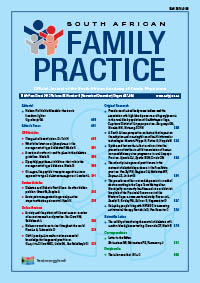Uptake and factors that affect enrolment into the prevention of mother-to-child transmission of human immunodeficiency virus programme in rural Limpopo Province
Keywords:
PMTCT, uptake, enrolment, factors
Abstract
Background: Before 2006, the uptake into the prevention of mother-to-child transmission (PMTCT) for HIV programme was low in South Africa. We determined PMTCT programme uptake, and identified factors that affected enrolment into the PMTCT programme in the rural Limpopo province. Method: This cross-sectional study, conducted from 21 July to 20 August 2008, involved 200 consecutive women who met the inclusion criteria in the immediate postpartum period. An interviewer-administered questionnaire was used to obtain information on participants’ knowledge and experience of, satisfaction with, and motivation for, enrolling in the PMTCT programme. Main outcome measures included voluntary counselling and testing (VCT) and PMTCT programme uptake rates, and factors reported to influence enrolment into the programme. Results: Of the 200 invited women, 169 (84.5%) responded. The mean age of participants was 25 years ± standard deviation. The human immunodeficiency virus prevalence rate was 23.6%. VCT and PMTCT programme uptakes were 96.9% and 90.9% respectively. Participants reported being aware of (95.2%) and satisfied with (81.6-97.4%) various aspects of the PMTCT programme. The safety of their babies was reported by most participants to be their motivation for enrolment (71.1%). Participants in the age-group 20-29 years were more likely than others to enrol in the PMTCT programme (p-value = 0.01). Conclusion: VCT and PMTCT programme uptakes were high and influenced by good knowledge, satisfaction with the PMTCT programme and participants’ concern for the safety of their babies.
Published
2013-04-16
Section
Original Research
By submitting manuscripts to SAFP, authors of original articles are assigning copyright to the South African Academy of Family Physicians. Copyright of review articles are assigned to the Publisher, Medpharm Publications (Pty) Ltd, unless otherwise specified. Authors may use their own work after publication without written permission, provided they acknowledge the original source. Individuals and academic institutions may freely copy and distribute articles published in SAFP for educational and research purposes without obtaining permission.

